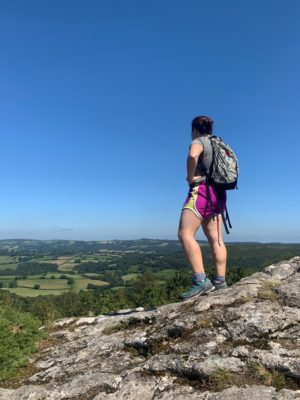We made it! After two more weeks of not getting sick – including at Katie’s wonderful birthday picnic in Victoria Park where she was (hopefully) impressed by our amateur production of The Five Doctors Acted Badly – last Saturday Randi and I both set our Out Of (Home) Offices, donned our fancy new reusable masks and began our train journey to the town of Church Stretton in the Shropshire Hills.
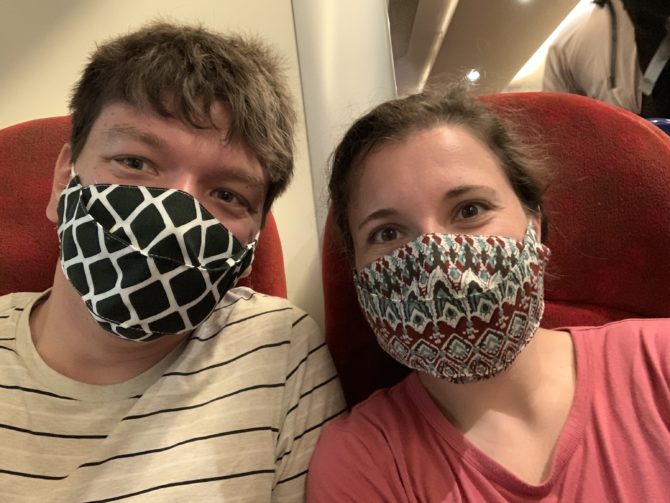
It really did take a lot of frustrated searching and many, many browser tabs to find an affordable self-catering cottage in a town which was simultaneously easy to reach, situated on a bunch of hilly walking routes and also had a bunch of pubs, takeaway options and a supermarket. Thankfully, Church Stretton ticks all of these boxes! I was also a little bit worried about rocking up somewhere too small and isolated where the residents wouldn’t be thrilled about incoming people right now, but I think Church Stretton is enough of a tourism-focused town to want visitors and we certainly never felt unwelcome anywhere.

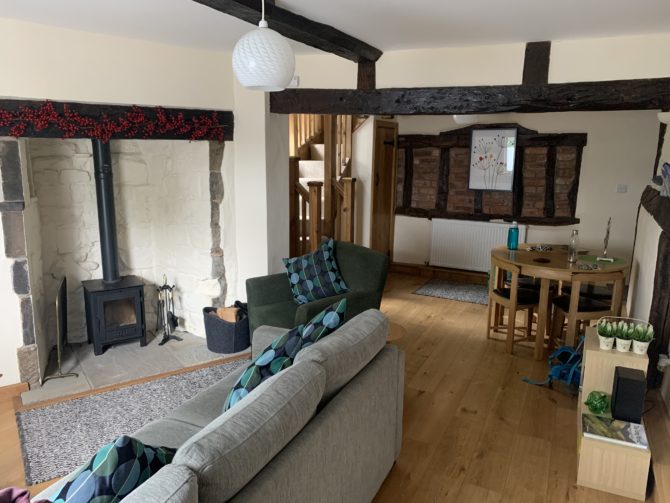

In general we alternated between decently long hikes (e.g. Caer Caradoc or Long Mynd, both of which sound like they come from the Narnia books) and lazier days of reading and playing Dominion. Things also took a surprising turn one evening where we consumed all of the complimentary wine and popcorn in the cottage and binged on CBBC’s entire evening schedule. But the obvious highlight was all of the food: some excellent takeaways, but also breakfasts at Berry’s and many pub meals in the inviting beer gardens of Church Stretton and nearby Little Stretton.
I know pubs have been open for a little while, but I’d been holding off until our holiday so hadn’t yet experienced that quintessentially British tradition (est. 2020) of providing your contact details at the bar before being seated. (I mention this mostly because all of our American friends seem bemused that this is socially enforceable.) I wasn’t sure what to expect, but the impression from absolutely everywhere is that people are really trying their best to comply with the rules and run their businesses at the same time, and there was always plenty of outdoor space to be able to relax. Summer is saved!




We hit the highest temperature on our last day, which made it the perfect moment to go swim in the Carding Mill Valley Reservoir. Well, I say ‘swim’ – while my mum would have been happily doing lengths, we were content for a very brief dip before sitting with our legs in the water as we watched kids jump off the bridge with varying degrees of athleticism.
I have to admit, watching both the children cajole each other into the water and the older teenagers chat, gossip and intone ruefully to each other that such-and-such “should have been a TikTok” did make me feel very old. As we dried off in the sun, I realised that we’re both totally invisible to them now; like the Borg, teeangers only perceive people around them if they are sufficiently interesting and don’t even see the others. Still, it was nice to see so many families enjoying themselves again.

At 20.30, two and a half hours before Brexit, I bowed to the victory of the Brexiteers by sitting alone in a Wetherspoons pub and ordering British pie and British mash through the Wetherspoons app. (Thirty minutes later I realised I had ordered it to the wrong pub, but the staff kindly saved me from my own idiocy.)
At 22.00, one hour before Brexit, I was sitting on a plane with my seatbelt fastened, waiting to take off.
And by 23.00 I was safely in the air, somewhere over France…

I’d love to pretend that this was all carefully planned, but it was just a happy coincidence that Randi was working in Barcelona last week and suggested I joined for the weekend. Obviously I was happy to do so, because (a) it’s Barcelona, but also (b) the city has always gotten a raw deal on this blog. I visited twice in 2003 – once on a school trip and then later with my family – but alas this was a year before I started blogging so it left an annoying hole on my virtual scratch map. Until now.


Since we had both been here before – albeit a while ago – we didn’t feel any pressure to rush around ticking off all the tourist sights. Instead we did a healthy amount of walking and wandering: eating tapas, marvelling at how different big cities can feel from each other (there are no houses!) and saying silly things to each other like “this reminds me of Buenos Aires”. I was also pleased to confirm that, after over a year of Duolingo, my Spanish is definitely in a better state than it was in 2003. And sure, nowadays I’m even more aware that you’d be wiser to speak Catalan here than Spanish, but I hope that the bar for British tourists is sufficiently low that I passed.

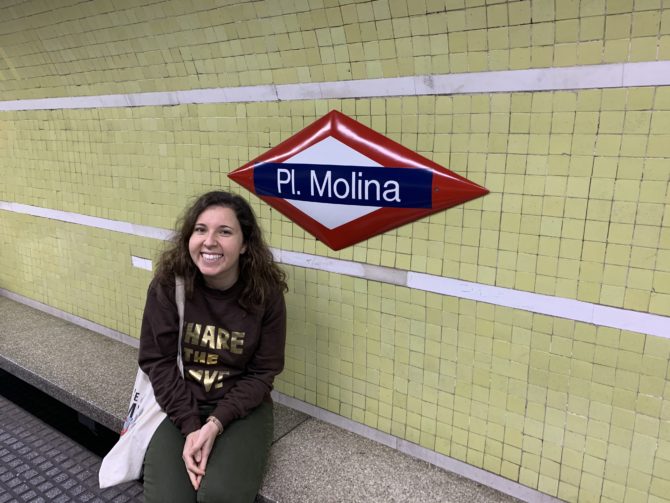
The one attraction we did pay for was the famous Park Güell which consists of a small ‘Monumental Zone’ of Gaudi sculptures and a much larger free area with rewarding views of the city, the sea and the mountains if you climb to the top. We sat up here for a while in the sun, basking in the warm glow of an unhurried weekend trip and the knowledge that Europe is still right here, just over the water, and it isn’t going anywhere.

Last week, Katie and I supplemented our regular Doctor Who outing with the first episode of the new Picard series. It seems strange now but I didn’t discover Doctor Who properly until I was a teenager, while Star Trek was deeply woven into my childhood: my mum (the only one who knew how to program the VCR) would always make sure it was set to record if my dad and I weren’t going to be home to watch it live. It should be noted that my dad loved both The Next Generation and Deep Space Nine the best, but for almost opposite reasons. The former is a utopian fantasy of peace and flourishing, the latter exposes the darker underbelly at the fringe. One is a manifesto, the other is a reality check. Both series need each other, and play off against each other.
From a dramatic perspective, however, you can’t tell any interesting stories if all you have is peace and flourishing. That wasn’t a problem for The Next Generation because it was set on a spaceship exploring new life and new civilisations. As long as those civilisations were violent and warlike then you had yourself a plot. But Picard is set on Earth, so it can’t play the same cards. Instead, the first episode features the perils of celebrity, xenophobia and a manipulative media… all good elements for a high-budget science-fiction show, but they also makes it feel like a show set in a higher-tech vision of Future America rather than a genuinely bold and radical imagining of a different social order.
This isn’t a complaint – I enjoyed the first episode and I’ll try to watch more – and even if it wanted to, the makers of Picard couldn’t recreate the The Next Generation anymore than my mum could still program a VCR. It was just a strange feeling, that’s all, that the vision of the future from the past now feels so much further away than our newer imagined future.
As for visions which look backwards: last Thursday I saw Tom Stoppard’s new play Leopoldstadt with my mum and cousin Alix. I had never seen a Tom Stoppard play before but apparently he has a reputation and the official reason for inviting me to tag along was that I might be able to “help explain what I thought it meant” at the end.
Leopoldstadt tells the story of a wealthy Jewish family starting in early twentieth century Vienna. Some of the family members have converted to Christianity for social reasons although everybody is still very much culturally Jewish, and together they debate questions of assimilation vs. identity etc. One member of the family acknowledges that anti-semitism is still present but optimistically argues that “pogroms are a thing of the past” and things will only get better. The audience is supposed to feel haunted by the dramatic irony, I suppose. As staged, it just felt like a cheap trick.
I have a big mostly-Jewish family on one side, studied mostly-modern history at university and have seen an above-average number of plays. So maybe I’m not the target audience here. But I’m going to trust my instincts and just assert that this isn’t a very good play. The characters are given a huge amount of clunking historical exposition (the British Mandate in Palestine one moment, Bolshevik revolution the next) for no good reason, the plot is full of clichés and the script abounds with arched contemporary references to make the audience feel worthy and knowing. There are so many powerful and moving works about this topic, but this isn’t one of them.
I’ve wanted to visit Amsterdam for a very, very long time and yet the city still exceeded my expectations, even on a grey and somewhat-rainy long weekend in October. So, this is my inevitable fawning blog post about Amsterdam.


We left London on an early Friday-morning Eurostar train from St Pancras with Simon and Fleur, with Steve following a few hours later. I have gushed about the joy of direct trains from London to Paris before, but direct trains from London to Amsterdam are even more wonderful and engender a feeling of European interconnectedness in a way that flying never can and never will. After a pancake and hot chocolate-based lunch we hopped on a bus to a farm just outside of the city and the one-of-a-kind waggon we had chosen to stay in. Sure, we could have gone for a hostel or something, but that wouldn’t have been half as much fun as our beloved waggon.




On Saturday we started with art at the Rijksmuseum and in particular its special exhibition Rembrandt-Velázquez – Dutch & Spanish Masters. As a piece of curation this was easily one of the best exhibitions I’ve ever seen. Rather than my usual feeling of ‘wandering through many paintings and feel like I’m not really appreciating it properly’, whoever curated this has systematically selected one Spanish and one Dutch painting on a similar theme (headined, as the title suggests, by Velázquez and Rembrandt) and then invited the visitor to compare the works side-by-side. Combined with excellent historical background text, the whole experience of walking through an art gallery suddenly felt meaningful for someone who loves history but doesn’t really know much about art. And, if you are childish like me, you can also keep a running score of Catholic vs. Protestant? by picking your favoured painting each time. (I think the Protestants won out in the end, but it was a close-run thing!)
After lunch we headed to our timed tour of the Anne Frank House. (Tip: you have to book this online in advance, so check before you visit.) Having finally read her famous diary last year I was really glad that we got a chance to visit the annexe behind a bookcase where she and her family, along with several others, hid from occupying Nazi forces for two years before being discovered and killed. There is not much I can mieaningfully add here, other than that the museum is very well designed and it is both strange and haunting to walk through the rooms which Anne wrote so much about in her diary.

Much of discovering Amsterdam felt like proving that the clichés were true, and not in a bad way. Yes, the homes lining the sides of the canals are incredibly pretty and charming. Yes, there is cannabis everywhere. And yes, cycling has a dominance and a naturalness (no helmets to be seen) which I’ve not seen in any other city in the world. What was especially exciting was finding this was still true even when we ventured outside of the most touristy areas, or late at night. With many cyclists, and few cars, it’s actually possible to have streets which feel calm and quiet without being empty.
Because all other transport modes can flourish together when cars are restricted, all of the other ways to get around Amsterdam were unsurprisingly but uniformly excellent too. The buses to and from our middle-of-nowhere stop by the motorway were astonishingly frequent. The trams across the city were great and – much to our amusement – sometimes contained an entire counter in the middle of the vehicle behind which a member of staff sat and (presumably) dispensed travel advice where needed.
And let’s not forget the Amsterdam Metro with its huge, beautiful stations filled with interesting art to admire in the couple of minutes before the next train would arrive. (To be fair, the line we used was only opened last year, so maybe it’s only fair that the stations look good.) On two occasions, by the way, random members of the great Dutch public stopped and explained the background to a piece of metro art that we were looking at.
We used one other mode of transport: a train to The Hague and back on Sunday, on which we had a bit of a surreal moment when a member of staff walked down the aisle and stopped to check “if everything was OK”. We had assumed she was a ticket inspector and had taken out our tickets to show her… but no, she was just checking if things were good. (On the same train, a young girl was practicing her English by having her mother call out English words and providing the Dutch translation. So we enjoyed a constant and quite adorable stream of pretty advanced vocabulary – “prison!” “pollution!” “pitchfork!”)
Anyway. Why did we go to The Hague in the first place? Why, to visit Madurodam of course! This ‘war memorial’ to a Dutch resistance fighter, George Maduro, is in fact a huge and utterly brilliant miniature park showcasing the best of The Netherlands at 1:25 scale. Although I could easily include hundreds of photos I will try and restrain myself a little, although if you check back in the post so far you may spot several model replicas already. Suffice to say: I loved it, from the intricate historical buildings and streetscapes to the big model industrial areas like Schiphol Airport.
There are so many wonderful little touches here, like the miniature Mars trucks which pick up real mini Mars bars from their mini warehouses, or the stricken cyclist lying by the stopped car. We also had a lot of fun at the immersive ‘New Amsterdam’ experience, which pits the plucky Dutch colonists against the nasty English pirates and – outnumbered – has them totally surrender as New Amsterdam becomes New York. I don’t know how anyone could fail to love Madurodam, and it is definitely worth the extra trip out of Amsterdam to see it.
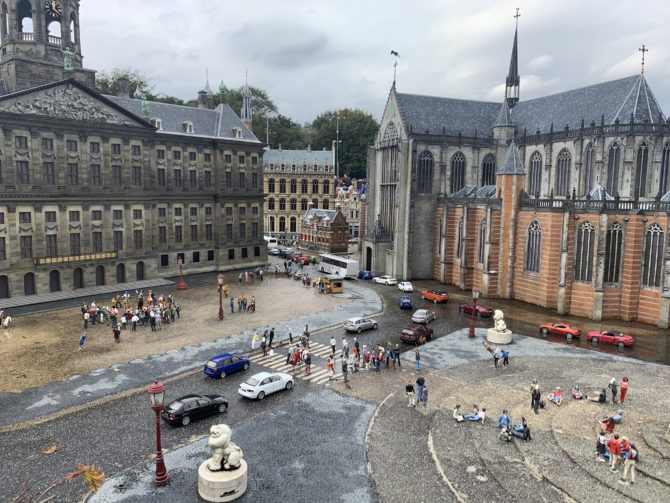



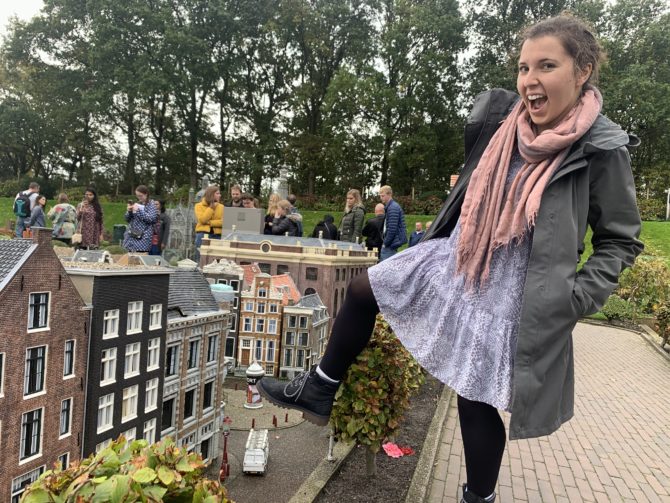


I haven’t even mentioned the food yet, but this was yet another highlight of our short trip. From pancakes to poffertjes, stroopwaffles to Surinamese food, we all ate pretty tremendously. My only regret was failing to realise that the Van Gogh Museum also runs exclusively on timed tickets and thus failing to get in before our train back home on Monday afternoon. Still, if there’s anywhere I now ‘have’ to go back to, I’m delighted that it’s Amsterdam.



Sadly the train home is not as magical as the way there since there are no passport control facilities (yet) at Amsterdam, meaning that everyone gets chucked off at Brussels, goes through the customary (but absurd) double British/Schengen passport control a few metres from each other and then waits in a too-small waiting area to get on a new train. Not to be outdone, the Home Office then insisted on a third passport check when we came off at St. Pancras. I asked the border agent what on earth this was for, and he responded that it was “only for certain trains”. “But… why?” “Because… well, why not?” On this stellar logic I am expecting passport checks at Brixton tube station in the morning. (Not that I want to give them any ideas.) Can’t we spend the money on someone to check if people on trains are OK instead?
But enough of the Home Office. I hope I have done enough to prove my newfound love for Amsterdam and the dry-humoured Dutch in general. Send me back any day!
This Bank Holiday weekend Randi and I took the slow train to Dartmoor in an ongoing quest to explore the UK’s National Parks. I’ll cheerfully admit that we can’t compete against the US for sheer awe, but the British version of a National Park will still provide impressive walks through beautiful countryside and/or other people’s fields of sheep. I had actually forgotten when we planned this that I had already visited Dartmoor a decade ago, but this time we did things our style by rolling up to Exeter Central and then joining a small but merry band of travellers on the ‘Country Bus’ to the village of Moretonhampstead.
I was, in fact, that person who had phoned Country Bus (“the local bus operator with a friendly face”) in advance to check if they took contactless cards, and the guy at the other end (who was indeed very friendly) confirmed that – as of a few weeks ago – they did! “But, just to let you know, it’s not like using your card at Sainsbury’s where you can just tap and be done. You really have to hold it.” He was right, but I was still very impressed by the technological advance. And so we rattled on happily up and down narrow country roads (and past a road sign which said “CAT’S EYES REMOVED” which disturbed Randi as apparently they do not use this term in the US) until we arrived at our destination.
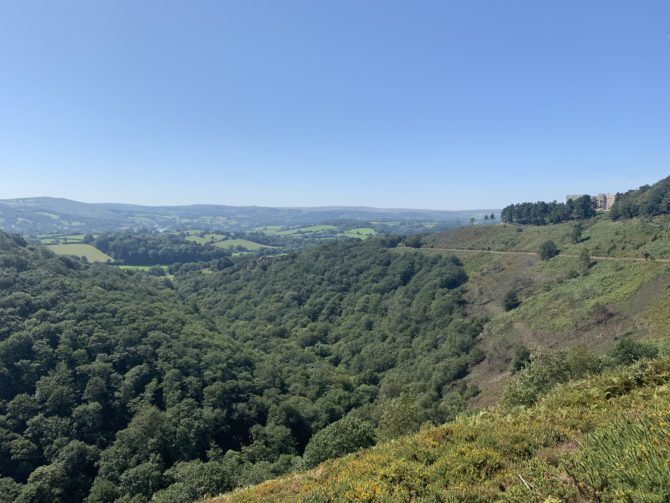
From here we followed a simple formula of eating large breakfasts, going on long walks and then eating large dinners. Wisely we decided to shell out for a paper map rather than relying on our phones, which was good because (a) I don’t think Google Maps is quite comfortable with hiking, and (b) on our second day we encountered a pair of proper walkers – one of whom sounded like a cousin of Gyles Brandreth – on top of Manaton Rocks. They were surprised and impressed that we had made it but also preemptively horrified that we might be using our phones to get around. Fortunately I could put their minds to rest with our laminated ‘Around & About’ (£3.99).

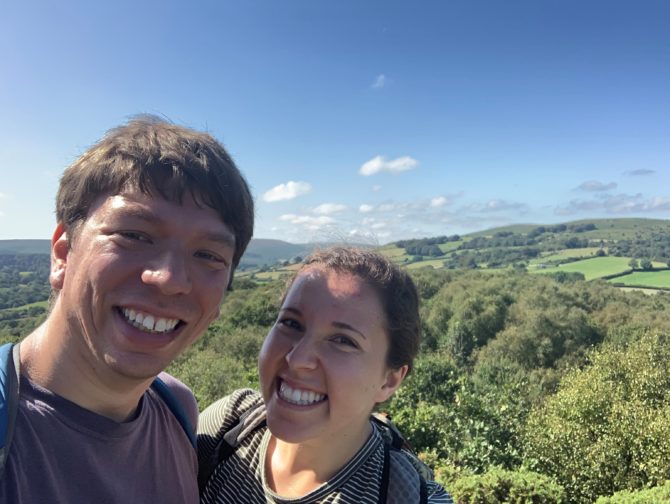
It was a simple but refreshing break, topped off on Tuesday night by the new season of Bake Off for which we were joined by Randi’s new friend Hala who had – surprisingly – never watched it before. Here’s to gentle vibes.
On Wednesday morning I received a 30th birthday e-mail from my 19 year-old self. It was sweetly good-natured as well as containing an alarmingly prescient warning about Boris Johnson, and it feels rude not to reply. To be fair, my 19 year-old self was just procrastinating from essay writing so it would probably be a bad idea to distract him even more. To make up for it, I will find some time to write a reply forward in time to my 40 year-old self instead, who I really hope has just enjoyed a birthday at least half as good as the one I’ve just had.
But I’m getting ahead of myself, and I don’t want to skip over the final few weeks of my twenties which – as promised last time – were all about settling down in our new flat and jobs and building the foundations of a routine. Our move to Tulse Hill was remarkably smooth (thanks partly to my mum who drove down a car loaded with suitcases and boxes!) and although we’re still waiting on some painting before we decorate properly the flat has slowly been filling up with everything it needs to feel like a home. In fact, on the very same day we moved in we also hopped down to IKEA Croydon to fill our backpacks with domestic essentials… and my very first journey on the hitherto mysterious world of London Trams.
In Chicago I really enjoyed my half-hour walk to and from work – not only as a chance to clear my head, but also as the perfect podcast listening time. So I’m really thrilled that I’ve been able to reproduce a 30-minute morning commute walk by heading to Brixton rather than just using the nearest station from our house. And as a bonus, I’ve swapped the industrial vibe of Goose Island (which, to be fair, I now have very fond memories of) for the breathtaking Brockwell Park. We are going to get an awful lot of use out of this park, especially on Sundays when there is an amazing farmers’ market just outside the park at Herne Hill station.

While Josh has the distinction of being our very first dinner guest, I was shocked to realise that the first people to stay overnight in our spare room would be Chicago’s very own Catherine and AJ! As I discovered when I walked into a pub on Wednesday evening and found them waiting at a table, our ‘surprise birthday weekend’ which Randi had organised for my 30th was actually for the four of us, which was both an incredible surprise and very touching that they would fly all the way here for only a couple of days. That night we joined up with my family for a plate-sharing extravaganza of Peruvian food (I was really hankering for some ají de gallina) before heading home together for the night.

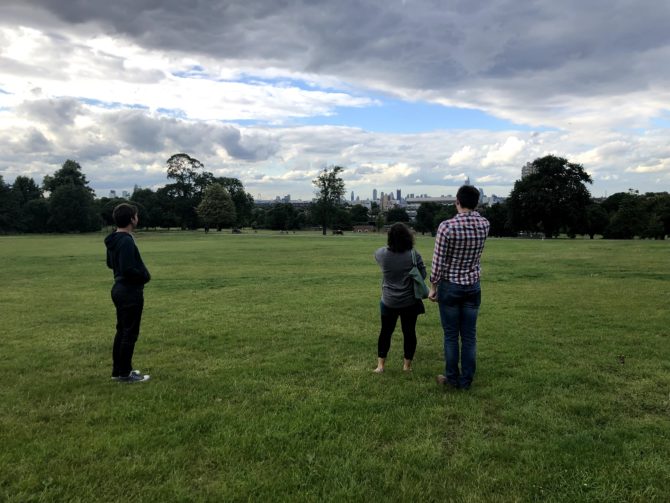

On Friday morning we ate a variety of English breakfasts at our new (and currently favourite) local café before catching the train to the coast for a long weekend in a small village near Dover. I have taken the Eurostar along the High Speed 1 route before but this was my first time riding the domestic high-speed service and the incorporation of this particular bit of railway nerdery into the birthday plan seems to have been a happy accident. We were all suitably impressed by how fast it was and as we shared cans of M&S cider and snacked on Percy Pigs it was galling to learn that a similar high-speed rail link connecting Chicago, Madison, Milwaukee and Minneapolis very nearly went ahead in 2010 before being scuppered by the asinine Republican governor of Wisconsin.


I had never been to the White Cliffs of Dover before and we were incredibly lucky on Saturday to get a perfect sunny day for a long stroll along the clifftop. The clear view of France across the channel really does bring home how geographically close the two countries are and, as if to make a point, my phone kept latching on to a French mobile network and pretending it was an hour later than it was. I challenge anyone to stare down at the port of Dover from above and casually opine that the single market is a trivial thing to mess around with. Once we got to Dover Castle we appreciated the usual medieval castle features (such a sentence is much less common in the US) as well as the Roman lighthouse and a tour/exhibition on Dunkirk presented in the ‘secret wartime tunnels’ which are signposted all over the site.


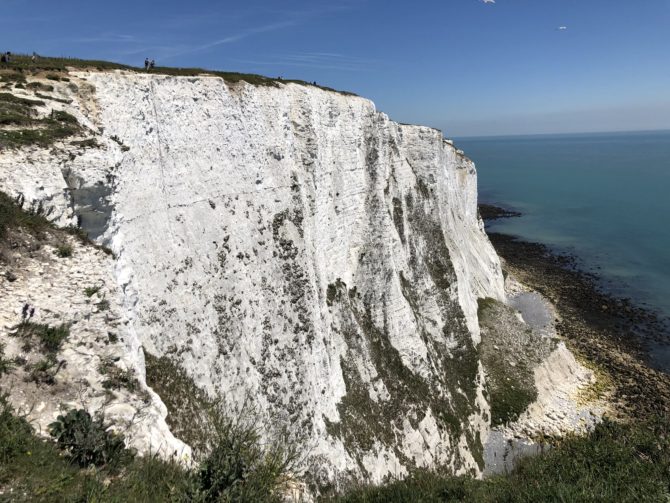

When not walking we did a lot of eating and drinking, from tea to vegan sausage rolls to three different chocolate caterpillar cakes (Charlie, Colin and Connie) which are not a staple of American birthday parties but ought to be. We also binged on Channel 4 (The Secret Life of Kids USA is notably didactic about parenting techniques compared to the UK version) and played an extensive game of Grand Austria Hotel, my board game birthday present from Katie. Predictably I also got upset about the cost, frequency and general demeanour of the very-non-London bus from Dover back to St Margaret’s at Cliffe… but I must admit that they do (finally!) take contactless card payments now, which is a real gamechanger if you find yourself relying on an unfamiliar rural route.



My 19 year-old self couldn’t have predicted how I would be spending my 30th birthday or who I would be spending it with, but he did have a hunch that I’d be enjoying myself. I’m really grateful to everyone who proved him right and made it so wonderful, kicking off my thirties in an exceptionally happy way.











